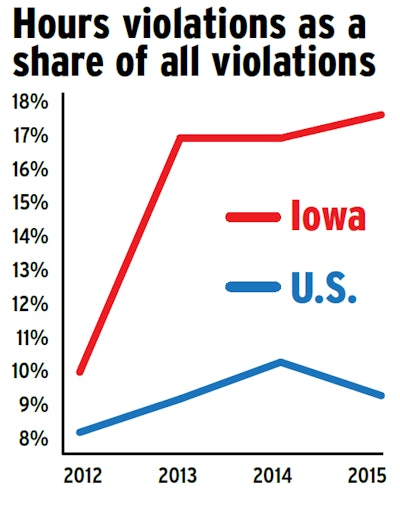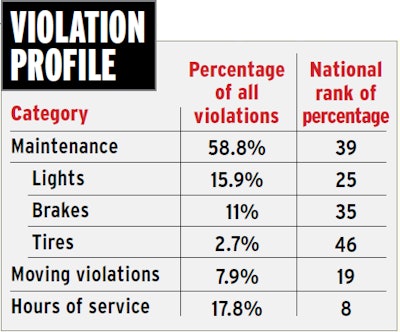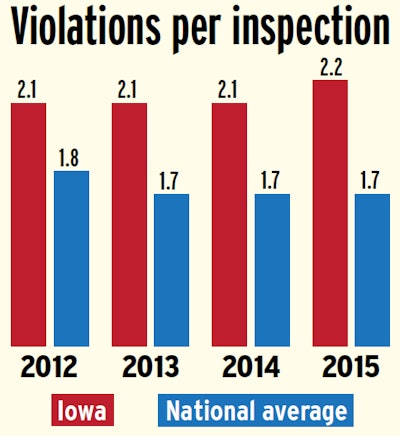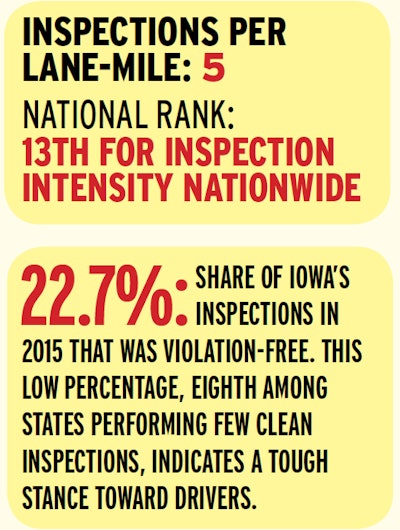
Shares of vehicle-related violations in Iowa are falling, while shares in other violation categories – hours, moving violations – are growing, says Chief David Lorenzen, head of the Motor Vehicle Enforcement division of the Iowa Department of Transportation.
 All data in this story based on 2015 federal inspection/violation numbers analyzed by Overdrive and sister company RigDig Business Intelligence. Access data in a variety of violation and inspection categories via the CSA’s Data Trail series main hub.
All data in this story based on 2015 federal inspection/violation numbers analyzed by Overdrive and sister company RigDig Business Intelligence. Access data in a variety of violation and inspection categories via the CSA’s Data Trail series main hub.Lorenzen agrees that his state’s violation profile in some senses reflects broad national trends. A quick look at Iowa’s violation profile shown with this story, however, shows a somewhat outsized focus on the driver rather than the truck.
That’s no accident, Lorenzen suggests. In tandem with the Federal Motor Carrier Safety Administration’s directives to Motor Carrier Safety Assistance Program funding recipients among states, Iowa had emphasized moving violations over the last decade or so.


Lorenzen says the increasing focus on the driver also stems from a growing use of screening technology at weigh stations – where Iowa conducts about half of its inspections – and at roadside via officers’ laptops. All of the roughly 100 dedicated inspectors in Iowa are sworn law officers, splitting their time between fixed locations and the road.
Six of the state’s 10 interstate-system weigh stations are equipped with PrePass’ screening/sorting technology. Last year, the state instituted the company’s 360 SmartView at Dallas and Jasper, sites on either side of Des Moines on I-80. The system combines plate/DOT number-reading cameras with other technologies to provide officers with advance information about not only PrePass-equipped trucks but also every truck that approaches a weigh station.
“We’re not stopping and wasting drivers’ time,” Lorenzen believes, as officers are better able to identify drivers for an inspection based on advance information. The use of 360 SmartView also could underpin another area where Iowa bucked the trend in the last year. Its violations-per-inspection ratio rose to 2.2 violations, while the national average stayed flat.

Officers on the road have laptops equipped with screening software that allows near-real-time visibility into a carrier’s safety measurement profile with the simple entry of a DOT number. “It’s been a reliable piece for us,” says Lorenzen. All Iowa officers also are equipped for mobile weight enforcement with portable scale units in their Chevy Tahoe police vehicles.
“Our full-time employees aren’t increasing” as a state budgetary priority, Lorenzen says. With technology, Iowa can do more in the way of inspections with what they have.
Lorenzen says truck and driver safety has improved during his near-40-year career in the state’s truck enforcement division. “Equipment has gotten much, much better,” he says. “When I first started, it was nothing for 50 percent of trucks inspected to be placed out of service.”
 Iowa’s Department of Transportation shows clear emphasis on inspecting the trucks and drivers it believes need it. The state stands out in rankings for the fewest clean inspections and an above-average violations-per-inspection rating. Add to that a top-15 ranking among states in inspection intensity, and it’s clear the sworn officers that make up much of the DOT’s program are among the nation’s most active in selection and inspection.
Iowa’s Department of Transportation shows clear emphasis on inspecting the trucks and drivers it believes need it. The state stands out in rankings for the fewest clean inspections and an above-average violations-per-inspection rating. Add to that a top-15 ranking among states in inspection intensity, and it’s clear the sworn officers that make up much of the DOT’s program are among the nation’s most active in selection and inspection.As for the drivers, most today are professional in their interactions, but Lorenzen understands the “frustration factor” that comes with being inspected. “Be knowledgeable of what’s required of you,” he says. “Do your due diligence” during pretrips, and “if you note equipment issues, make sure you take care of them.”
Iowa’s inspection program isn’t going anywhere anytime soon, Lorenzen says. “We’re always going to be out there,” he says. “We train our officers to expedite the process. We want to get you there safely, but also efficiently and conveniently. We don’t want to hinder anything.”
Find all of the CSA’s Data Trail state profiles via the links below:











